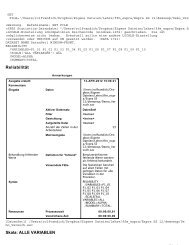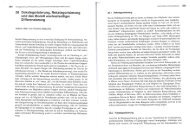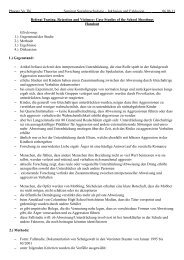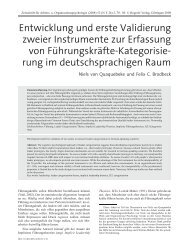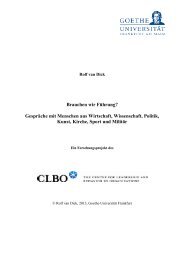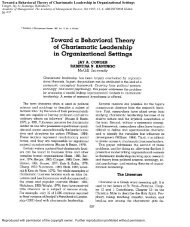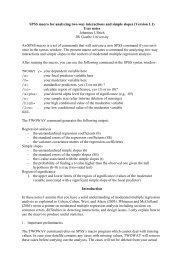No need to fake it: Reproduction of the Asch experiment without ...
No need to fake it: Reproduction of the Asch experiment without ...
No need to fake it: Reproduction of the Asch experiment without ...
Create successful ePaper yourself
Turn your PDF publications into a flip-book with our unique Google optimized e-Paper software.
This article was downloaded by: [Inst<strong>it</strong>utional Subscription Access]<br />
On: 27 September 2011, At: 06:22<br />
Publisher: Psychology Press<br />
Informa Ltd Registered in England and Wales Registered Number: 1072954 Registered <strong>of</strong>fice: Mortimer<br />
House, 37-41 Mortimer Street, London W1T 3JH, UK<br />
International Journal <strong>of</strong> Psychology<br />
Publication details, including instructions for authors and subscription information:<br />
http://www.tandfonline.com/loi/pijp20<br />
<strong>No</strong> <strong>need</strong> <strong>to</strong> <strong>fake</strong> <strong>it</strong>: <strong>Reproduction</strong> <strong>of</strong> <strong>the</strong> <strong>Asch</strong><br />
<strong>experiment</strong> w<strong>it</strong>hout confederates<br />
Kazuo Mori a & Miho Arai b<br />
a Tokyo Univers<strong>it</strong>y <strong>of</strong> Agriculture and Technology, Tokyo, Japan<br />
b Kan<strong>to</strong> Gakuen Univers<strong>it</strong>y, Gunma, Japan<br />
Available online: 25 May 2010<br />
To c<strong>it</strong>e this article: Kazuo Mori & Miho Arai (2010): <strong>No</strong> <strong>need</strong> <strong>to</strong> <strong>fake</strong> <strong>it</strong>: <strong>Reproduction</strong> <strong>of</strong> <strong>the</strong> <strong>Asch</strong> <strong>experiment</strong> w<strong>it</strong>hout<br />
confederates, International Journal <strong>of</strong> Psychology, 45:5, 390-397<br />
To link <strong>to</strong> this article: http://dx.doi.org/10.1080/00207591003774485<br />
PLEASE SCROLL DOWN FOR ARTICLE<br />
Full terms and cond<strong>it</strong>ions <strong>of</strong> use: http://www.tandfonline.com/page/terms-and-cond<strong>it</strong>ions<br />
This article may be used for research, teaching and private study purposes. Any substantial or<br />
systematic reproduction, re-distribution, re-selling, loan, sub-licensing, systematic supply or distribution<br />
in any form <strong>to</strong> anyone is expressly forbidden.<br />
The publisher does not give any warranty express or implied or make any representation that <strong>the</strong><br />
contents will be complete or accurate or up <strong>to</strong> date. The accuracy <strong>of</strong> any instructions, formulae and drug<br />
doses should be independently verified w<strong>it</strong>h primary sources. The publisher shall not be liable for any<br />
loss, actions, claims, proceedings, demand or costs or damages whatsoever or howsoever caused arising<br />
directly or indirectly in connection w<strong>it</strong>h or arising out <strong>of</strong> <strong>the</strong> use <strong>of</strong> this material.
Downloaded by [Inst<strong>it</strong>utional Subscription Access] at 06:22 27 September 2011<br />
INTERNATIONAL JOURNAL OF PSYCHOLOGY, 2010, 45 (5), 390–397<br />
<strong>No</strong> <strong>need</strong> <strong>to</strong> <strong>fake</strong> <strong>it</strong>: <strong>Reproduction</strong> <strong>of</strong> <strong>the</strong> <strong>Asch</strong><br />
<strong>experiment</strong> w<strong>it</strong>hout confederates<br />
Kazuo Mori<br />
Tokyo Univers<strong>it</strong>y <strong>of</strong> Agriculture and Technology, Tokyo, Japan<br />
Miho Arai<br />
Kan<strong>to</strong> Gakuen Univers<strong>it</strong>y, Gunma, Japan<br />
I<br />
n <strong>the</strong> present <strong>experiment</strong>, we replicated <strong>Asch</strong>’s seminal study on social conform<strong>it</strong>y w<strong>it</strong>hout using confederates.<br />
We adapted a presentation trick in order <strong>to</strong> present two different stimuli secretly <strong>to</strong> groups <strong>of</strong> participants <strong>to</strong><br />
create minor<strong>it</strong>ies and major<strong>it</strong>ies w<strong>it</strong>hout utilizing confederates. One hundred and four Japanese undergraduates<br />
(40 men and 64 women) carried out <strong>Asch</strong>-equivalent tasks in same-sex groups <strong>of</strong> four. In each group, we adapted<br />
<strong>the</strong> fMORI Technique <strong>to</strong> present <strong>the</strong> tasks such that one person (minor<strong>it</strong>y participant) observed different stimuli<br />
than <strong>the</strong> o<strong>the</strong>r three people (major<strong>it</strong>y participants). The same nine stimulus sets that <strong>Asch</strong> had used were carefully<br />
reproduced as PowerPoint slides and projected on<strong>to</strong> a half-transparent screen. As for <strong>the</strong> cr<strong>it</strong>ical tasks, <strong>the</strong> <strong>to</strong>p<br />
part <strong>of</strong> <strong>the</strong> standard lines appeared in e<strong>it</strong>her green or magenta so that two groups <strong>of</strong> participants would see <strong>the</strong>m<br />
differently when <strong>the</strong>y wore two types <strong>of</strong> polarizing sunglasses that filtered e<strong>it</strong>her green or magenta <strong>to</strong> make <strong>the</strong><br />
lines appear longer or shorter. A post-<strong>experiment</strong>al questionnaire confirmed that no participant among e<strong>it</strong>her <strong>the</strong><br />
minor<strong>it</strong>y or major<strong>it</strong>y viewers noticed <strong>the</strong> presentation trick. The results showed that, in line w<strong>it</strong>h <strong>Asch</strong>’s basic<br />
findings, <strong>the</strong> minor<strong>it</strong>y women participants conformed <strong>to</strong> <strong>the</strong> major<strong>it</strong>y. However, our study produced two<br />
different results: While minor<strong>it</strong>y women conformed, minor<strong>it</strong>y men did not. Contrary <strong>to</strong> <strong>Asch</strong>’s findings, <strong>the</strong><br />
frequency <strong>of</strong> conform<strong>it</strong>y <strong>of</strong> minor<strong>it</strong>y participants was almost <strong>the</strong> same regardless <strong>of</strong> whe<strong>the</strong>r <strong>the</strong> major<strong>it</strong>y<br />
answered unanimously or not.<br />
Keywords: <strong>Asch</strong>; Line judgment tasks; Conform<strong>it</strong>y; Confederates; fMORI technique.<br />
D<br />
ans cette expérience, nous avons re´plique´ l’e´tude se´minale de <strong>Asch</strong> sur la conform<strong>it</strong>e´ sociale sans utiliser des<br />
complices. <strong>No</strong>us avons adapte´ un trucage de pre´sentation dans le but de pre´senter secre` tement deux stimuli<br />
diffe´rents aux groupes de participants afin de cre´er des minor<strong>it</strong>e´s et des major<strong>it</strong>e´s sans utiliser les complices.<br />
Cent quatre étudiants japonais du premier cycle univers<strong>it</strong>aire (40 hommes et 64 femmes) ont exe´cute´ des taˆches<br />
e´quivalentes a` l’expérience de <strong>Asch</strong> dans des groupes de meˆme sexe de quatre. Dans chaque groupe, nous avons<br />
adapte´ la technique fMORI pour pre´senter les tâches de manie` re a` ce qu’une personne (participant minor<strong>it</strong>aire)<br />
a<strong>it</strong> observe´ diffe´rents stimuli en comparaison aux trois autres personnes (participants major<strong>it</strong>aires). Les meˆmes<br />
sets de stimuli qu’Ash ava<strong>it</strong> utilise´s ont été soigneusement reprodu<strong>it</strong>s comme des diapos<strong>it</strong>ives de Powerpoint<br />
et projete´s sur un e´cran mi-transparent. En ce qui concerne les tâches cr<strong>it</strong>iques, la partie supérieure des lignes<br />
standards a apparu so<strong>it</strong> en vert, so<strong>it</strong> en magenta. Ceci a permis a` deux groupes de participants de les voir<br />
diffe´remment quand ils portaient deux types de lunettes de soleil polarisant qui filtraient so<strong>it</strong> le vert, so<strong>it</strong> le<br />
magenta pour faire apparaître les lignes comme étant plus longues ou plus courtes. La nouvelle proce´dure<br />
expe´rimentale a fonctionne´ pour reproduire l’expe´rimentation d’<strong>Asch</strong> sans le recours aux complices.<br />
Un questionnaire post-expe´rimental a confirme´ qu’aucun participant parmi les spectateurs, ni minor<strong>it</strong>aires ni<br />
major<strong>it</strong>aires, a remarque´ le trucage de pre´sentation. Les re´sultats ont indiqué qu’en accord avec les résultats de<br />
Correspondence should be addressed <strong>to</strong> Kazuo Mori, Inst<strong>it</strong>ute <strong>of</strong> Technology, Tokyo Univers<strong>it</strong>y <strong>of</strong> Agriculture and Technology,<br />
24-16 Nakacho 2-chome, Koganei, Tokyo, Japan 184-8588. (E-mail: kaz-mori@cc.tuat.ac.jp).<br />
This research was supported by a Grant-in-Aid from <strong>the</strong> Japanese Ministry <strong>of</strong> Education, Culture, Sports, Science, and<br />
Technology (Grant <strong>No</strong>. 16653054) <strong>to</strong> KM while <strong>the</strong> authors were at Shinshu Univers<strong>it</strong>y. We are indebted more than two bowls<br />
<strong>of</strong> udon <strong>to</strong> Maryanne Garry and Harlene Hayne for <strong>the</strong>ir pr<strong>of</strong>essional advice on earlier drafts. We also wish <strong>to</strong> thank Rebecca<br />
Ann Marck for her superb work in ed<strong>it</strong>ing <strong>the</strong> English manuscript.<br />
ß 2010 International Union <strong>of</strong> Psychological Science<br />
http://www.psypress.com/ijp DOI: 10.1080/00207591003774485
Downloaded by [Inst<strong>it</strong>utional Subscription Access] at 06:22 27 September 2011<br />
base d’<strong>Asch</strong>, les femmes participantes minor<strong>it</strong>aires se sont conforme´es à la major<strong>it</strong>e´. Cependant, notre e´tude a<br />
produ<strong>it</strong> deux re´sultats diffe´rents: tandis que les femmes minor<strong>it</strong>aires se sont conforme´es, les hommes minor<strong>it</strong>aires<br />
ne l’ont pas fa<strong>it</strong>. Contrairement aux résultats d’<strong>Asch</strong>, la fréquence de la conform<strong>it</strong>e´ des participants minor<strong>it</strong>aires<br />
e´ta<strong>it</strong> presque la meˆme inde´pendamment du fa<strong>it</strong> que la major<strong>it</strong>e´ are´pondu unanimement ou pas<br />
E<br />
n el presente experimen<strong>to</strong> se replico´ el estudio ba´sico de <strong>Asch</strong> sobre la conformidad social sin el uso de<br />
aliados. <strong>No</strong>so<strong>to</strong>s adaptamos el experimen<strong>to</strong> utilizando un artificio especial con el objetivo de presentar de<br />
manera secreta dos estı´mulos diferentes a un grupo de participantes, con el fin der crear minorı´as o mayorı´as sin<br />
la utilizacio´n de aliados. Cien<strong>to</strong> cuatro estudiantes japoneses (40 hombres y 64 mujeres) desarrollaron tareas<br />
equivalentes a las de <strong>Asch</strong> en grupos de cuatro personas del mismo sexo. En cada grupo adaptamos la técnica<br />
fMORI para presentar las tareas de tal manera que una persona (participante en minorı´a) observará el estímulo<br />
presentado de manera diferente a los otros tres participantes (participantes en mayorı´a). Los mismos nueve<br />
estímulos que <strong>Asch</strong> utilizo´, fueron reproducidos cuidadosamente en transparencias de Power Point y proyectadas<br />
en una pantalla semi-transparente. Respec<strong>to</strong> de la tarea principal, la parte superior de las lı´neas estandarizadas<br />
aparecı´an en color verde o magenta. El uso de dos tipos diferentes de lentes de sol polarizados que filtraban el<br />
verde o el magenta generaban la sensacio´n de que las lı´neas era ma´s largas o más cortas, de tal manera que los dos<br />
grupos de participantes percibı´an estas líneas de manera diferente. Este nuevo procedimien<strong>to</strong> <strong>experiment</strong>al<br />
funciona de tal manera que se puede reproducir el experimen<strong>to</strong> de <strong>Asch</strong> sin necesidad de aliados. La aplicacio´nde<br />
cuestionarios despue´s del experimen<strong>to</strong> confirmo´ que ningu´n participante tan<strong>to</strong> en el grupo minor<strong>it</strong>ario como en el<br />
mayor<strong>it</strong>ario se dio´ cuenta del artificio. Los resultados mostraron de manera similar a los descubrimien<strong>to</strong>s ba´sicos<br />
de <strong>Asch</strong>, que la minorı´a de mujeres estuvo de acuerdo con lo que postulo´ la mayorı´a. Sin embargo en este estudio<br />
se observaron dos resultados diferentes: mientras que la minorı´a de mujeres estuvo conforme, la minorı´a de<br />
hombres no lo estuvo. Contrario a los descubrimien<strong>to</strong>s de <strong>Asch</strong>, la frecuencia de la conformidad de la minorı´a de<br />
participantes fue siempre la misma independientemente de que la mayorı´a contestara´ de manera unánime o no<br />
In one <strong>of</strong> psychology’s classic studies, <strong>Asch</strong> (1955,<br />
1956, 1958) showed that individuals sometimes<br />
conformed <strong>to</strong> <strong>the</strong> responses <strong>of</strong> a unanimous<br />
major<strong>it</strong>y even when <strong>the</strong> major<strong>it</strong>y seemed <strong>to</strong> have<br />
made a wrong choice. In <strong>the</strong>se studies, <strong>Asch</strong> asked<br />
a group <strong>of</strong> people <strong>to</strong> make a simple visual<br />
discrimination. Most <strong>of</strong> <strong>the</strong> group comprised<br />
confederates, who had been instructed <strong>to</strong> respond<br />
incorrectly and unanimously on several trials; <strong>the</strong><br />
odd person out was <strong>the</strong> participant. <strong>Asch</strong> found<br />
that about 30% <strong>of</strong> participants conformed <strong>to</strong> <strong>the</strong><br />
major<strong>it</strong>y even though <strong>the</strong>y knew <strong>the</strong> major<strong>it</strong>y was<br />
incorrect. He also found that conform<strong>it</strong>y was<br />
strongest when <strong>the</strong> major<strong>it</strong>y had made a unanimous<br />
decision. These findings have been replicated<br />
using a number <strong>of</strong> different manipulations<br />
(see Bond & Sm<strong>it</strong>h, 1996, for review), but have<br />
always relied on confederates <strong>to</strong> present <strong>the</strong><br />
major<strong>it</strong>y view.<br />
Although confederates <strong>of</strong>ten play an important<br />
role in psychological science, using <strong>the</strong>m has<br />
certain drawbacks. One intrinsic problem is that<br />
<strong>the</strong>y behave in a manner that is somewhat<br />
unnatural and artificial. Even well-trained confederates<br />
<strong>of</strong>ten violate <strong>the</strong> norms for social interaction<br />
by engaging in stilted conversations and raising<br />
participants’ suspicions about <strong>the</strong> real purpose <strong>of</strong><br />
<strong>the</strong> <strong>experiment</strong>. In fact, following <strong>the</strong> publication<br />
<strong>of</strong> <strong>Asch</strong>’s original <strong>experiment</strong>, Crutchfield (1955)<br />
raised <strong>the</strong> problem <strong>of</strong> using confederates in<br />
research on social conform<strong>it</strong>y, and he developed<br />
ASCH EXPERIMENT WITHOUT CONFEDERATES 391<br />
an alternative conform<strong>it</strong>y procedure in which each<br />
participant sat separately in a cubicle. The<br />
<strong>experiment</strong>er <strong>the</strong>n fed participants information<br />
that presumably came from <strong>the</strong> o<strong>the</strong>r participants.<br />
Although <strong>the</strong> Crutchfield paradigm gets around<br />
<strong>the</strong> problem <strong>of</strong> using confederates, <strong>it</strong> eliminates<br />
face-<strong>to</strong>-face interaction between participants that<br />
may have important effects on conform<strong>it</strong>y.<br />
The <strong>Asch</strong> conform<strong>it</strong>y <strong>experiment</strong>s have been<br />
repeated w<strong>it</strong>h a variety <strong>of</strong> independent variables<br />
(culture, sex, response cond<strong>it</strong>ions, etc.) for more<br />
than half a century (Bond & Sm<strong>it</strong>h, 1996), but<br />
from <strong>the</strong> beginning <strong>the</strong>re were cr<strong>it</strong>icisms about <strong>the</strong><br />
procedure. Stricker, Messick, and Jackson (1967)<br />
reported that many participants were suspicious <strong>of</strong><br />
<strong>the</strong> purpose <strong>of</strong> <strong>the</strong> <strong>Asch</strong> <strong>experiment</strong>al procedure.<br />
More recently, Hodges and Geyer (2006) quoted<br />
an anecdote reported in <strong>Asch</strong> (1951): that a<br />
participant who always dissented ‘‘announced’’<br />
all disagreeing answers in <strong>the</strong> form <strong>of</strong> ‘‘Three, sir,’’<br />
but did not do this when everyone gave <strong>the</strong> correct<br />
answer.<br />
There were some negative findings <strong>of</strong> conform<strong>it</strong>y<br />
<strong>it</strong>self. For example, Allen and Levine (1969)<br />
reported counterevidence <strong>of</strong> <strong>the</strong> well-known<br />
unanim<strong>it</strong>y effect <strong>of</strong> conform<strong>it</strong>y. Perrin and<br />
Spencer (1981) reported that no conform<strong>it</strong>y was<br />
found in <strong>the</strong>ir replication <strong>of</strong> <strong>the</strong> <strong>Asch</strong> <strong>experiment</strong>.<br />
Standing and Lalancette (1990) found that even<br />
w<strong>it</strong>h a more ambiguous task, thus in a more<br />
conform<strong>it</strong>y-inducing cond<strong>it</strong>ion, no conform<strong>it</strong>y was
Downloaded by [Inst<strong>it</strong>utional Subscription Access] at 06:22 27 September 2011<br />
392 MORI AND ARAI<br />
observed in <strong>the</strong> <strong>Asch</strong> <strong>experiment</strong>. Whe<strong>the</strong>r or not<br />
<strong>the</strong> observed conform<strong>it</strong>y in <strong>the</strong> <strong>Asch</strong> <strong>experiment</strong>s<br />
was really conform<strong>it</strong>y <strong>to</strong> <strong>the</strong> group has also been<br />
addressed by many scholars (see a review by<br />
Hodges & Geyer, 2006). Schulman (1967) compared<br />
<strong>the</strong> effects <strong>of</strong> <strong>the</strong> <strong>experiment</strong>er and <strong>the</strong> group<br />
using a fac<strong>to</strong>rial <strong>experiment</strong>al design and found<br />
that <strong>the</strong> performance <strong>of</strong> <strong>the</strong> participants was<br />
affected not only by <strong>the</strong> group but also by <strong>the</strong><br />
presence <strong>of</strong> <strong>the</strong> <strong>experiment</strong>er. The participants<br />
tended <strong>to</strong> answer taking account <strong>of</strong> <strong>the</strong> assumed<br />
expectations <strong>of</strong> <strong>the</strong> <strong>experiment</strong>er.<br />
Although <strong>the</strong> <strong>Asch</strong> conform<strong>it</strong>y <strong>experiment</strong>s have<br />
been regarded as well-established studies on <strong>the</strong><br />
conform<strong>it</strong>y <strong>of</strong> minor<strong>it</strong>y <strong>to</strong> major<strong>it</strong>y, <strong>the</strong> <strong>experiment</strong>al<br />
findings have been somewhat inconsistent<br />
across studies. There have been many follow-up<br />
studies that found conform<strong>it</strong>y under various<br />
cond<strong>it</strong>ions as reviewed in Bond and Sm<strong>it</strong>h<br />
(1996), while <strong>the</strong>re have been contradic<strong>to</strong>ry studies<br />
that found no conform<strong>it</strong>y at all. One possible<br />
source <strong>of</strong> this inconsistency might be related <strong>to</strong> <strong>the</strong><br />
use <strong>of</strong> confederates. While well-trained and highly<br />
motivated confederates might behave in such a<br />
way as <strong>to</strong> increase conform<strong>it</strong>y, less well-trained or<br />
less motivated confederates might decrease conform<strong>it</strong>y.<br />
Complicating matters fur<strong>the</strong>r, <strong>the</strong>re may<br />
be individual differences in participants’ abil<strong>it</strong>y <strong>to</strong><br />
detect <strong>the</strong> presence <strong>of</strong> confederates. For example,<br />
Walker and Andrade (1996) conducted <strong>the</strong> <strong>Asch</strong><br />
(1956) conform<strong>it</strong>y tasks w<strong>it</strong>h five age groups <strong>of</strong><br />
children (3–5, 6–8, 9–11, 12–14, and 15–17 years<br />
old) <strong>to</strong> examine <strong>the</strong> development <strong>of</strong> conform<strong>it</strong>y.<br />
They used pre-trained confederates chosen from<br />
<strong>the</strong> same classroom as <strong>the</strong> participants. They<br />
found that younger participants were more likely<br />
<strong>to</strong> conform. Although <strong>the</strong>y interpreted <strong>the</strong>se<br />
results as evidence that conform<strong>it</strong>y decreases w<strong>it</strong>h<br />
age, <strong>it</strong> is equally possible that older children were<br />
more likely than younger children <strong>to</strong> detect <strong>the</strong><br />
presence <strong>of</strong> confederates. In order <strong>to</strong> properly<br />
examine <strong>the</strong> effects <strong>of</strong> major<strong>it</strong>y decision on<br />
conform<strong>it</strong>y, <strong>it</strong> would be ideal <strong>to</strong> have a procedure<br />
that did not require <strong>the</strong> use <strong>of</strong> confederates. Here,<br />
we report <strong>the</strong> results <strong>of</strong> new procedure that can be<br />
used <strong>to</strong> study social conform<strong>it</strong>y but that does not<br />
rely on <strong>the</strong> use <strong>of</strong> confederates.<br />
In 2003, Mori developed a new technique that<br />
allows researchers <strong>to</strong> study a wide range <strong>of</strong> social<br />
conform<strong>it</strong>y phenomena w<strong>it</strong>hout using confederates.<br />
The MORI technique (Manipulation <strong>of</strong><br />
Overlapping Rivalrous Images by polarizing filters)<br />
allows <strong>experiment</strong>ers <strong>to</strong> present two different<br />
movies simultaneously <strong>to</strong> two groups <strong>of</strong> viewers,<br />
who remain unaware <strong>of</strong> <strong>the</strong> dual<strong>it</strong>y. The technique<br />
was originally developed <strong>to</strong> examine how<br />
discussion among potential w<strong>it</strong>nesses might alter<br />
<strong>the</strong>ir subsequent report <strong>of</strong> an event (Garry,<br />
French, Kinzett, & Mori, 2008; Kanematsu,<br />
Mori, & Mori, 2003; Mori & Mori, 2008), but<br />
<strong>the</strong>re is no reason that <strong>the</strong> MORI technique must<br />
be lim<strong>it</strong>ed <strong>to</strong> <strong>the</strong> study <strong>of</strong> eyew<strong>it</strong>ness memory.<br />
It could also be used <strong>to</strong> examine how discrepancies<br />
influence myriad behaviors—behaviors such as<br />
those that <strong>Asch</strong> studied. In fact, Mori and Mori<br />
(2008) found that minor<strong>it</strong>y w<strong>it</strong>nesses tended <strong>to</strong><br />
conform <strong>to</strong> <strong>the</strong> reports <strong>of</strong> co-w<strong>it</strong>nesses. Thus, <strong>the</strong><br />
MORI technique has <strong>the</strong> potential <strong>to</strong> reproduce<br />
<strong>the</strong> same <strong>experiment</strong>al s<strong>it</strong>uation as <strong>Asch</strong>, but<br />
w<strong>it</strong>hout using confederates.<br />
In <strong>the</strong> present study, we attempted <strong>to</strong> replicate<br />
<strong>the</strong> original <strong>Asch</strong> <strong>experiment</strong> using <strong>the</strong> fMORI<br />
technique (Mori, 2007), which is a variation <strong>of</strong> <strong>the</strong><br />
MORI technique su<strong>it</strong>able for presenting two<br />
different static visual stimuli in a more precise<br />
manner. Our goal was <strong>to</strong> determine whe<strong>the</strong>r we<br />
could obtain social conform<strong>it</strong>y w<strong>it</strong>hout <strong>the</strong> use <strong>of</strong><br />
confederates. If we produced results similar <strong>to</strong><br />
those <strong>of</strong> <strong>Asch</strong> w<strong>it</strong>hout relying on confederates, <strong>it</strong><br />
would mean that <strong>the</strong> cr<strong>it</strong>icism <strong>of</strong> <strong>the</strong> <strong>Asch</strong> studies<br />
should not have stemmed from <strong>the</strong> <strong>experiment</strong>al<br />
procedure <strong>of</strong> using confederates. However, if a<br />
different finding were obtained from this ecologically<br />
valid <strong>experiment</strong>al paradigm w<strong>it</strong>hout using<br />
confederates, we would <strong>need</strong> <strong>to</strong> reexamine <strong>the</strong><br />
well-established findings about how people behave<br />
under social pressure.<br />
Participants<br />
METHOD<br />
One hundred and four undergraduates (40 men<br />
and 64 women) participated in same-sex groups<br />
<strong>of</strong> four. All <strong>of</strong> <strong>the</strong>m had normal or corrected-<strong>to</strong>normal<br />
vision. <strong>No</strong>te that in <strong>Asch</strong> (1956), only men<br />
participated. To allow us <strong>to</strong> examine possible<br />
gender differences, we included women in our<br />
sample.<br />
Experimental design<br />
The study was a 2 (role: minor<strong>it</strong>y vs. major<strong>it</strong>y)<br />
2 (sex: men, women) between-subjects fac<strong>to</strong>rial<br />
design. The procedural variables (types <strong>of</strong> sunglasses<br />
used by minor<strong>it</strong>y and order <strong>of</strong> tasks) were<br />
fully counterbalanced among participants. The<br />
dependent variable was <strong>the</strong> frequency <strong>of</strong> errors<br />
on <strong>the</strong> 12 cr<strong>it</strong>ical tasks for each participant.
Downloaded by [Inst<strong>it</strong>utional Subscription Access] at 06:22 27 September 2011<br />
Stimuli<br />
We used Adobe Pho<strong>to</strong>shop <strong>to</strong> recreate <strong>the</strong> same<br />
nine stimulus sets that <strong>Asch</strong> (1956) had used.<br />
In <strong>Asch</strong> (1956), <strong>the</strong> standard line was drawn in<br />
black on a wh<strong>it</strong>e card and <strong>the</strong> three comparison<br />
lines were drawn on ano<strong>the</strong>r card. The two cards<br />
were shown 40 inches (about 1 m) apart. In <strong>the</strong><br />
present <strong>experiment</strong>, our standard and comparison<br />
lines appeared on <strong>the</strong> same screen about 1 m apart.<br />
The standard line appeared on <strong>the</strong> left <strong>of</strong> <strong>the</strong><br />
screen and was 5.08 <strong>to</strong> 25.40 cm (2 <strong>to</strong> 10 inches)<br />
long, <strong>the</strong> same length as on <strong>the</strong> cards used in <strong>Asch</strong><br />
(1956). The three comparison lines were also<br />
replicated in <strong>the</strong> same length as those <strong>of</strong> <strong>Asch</strong><br />
(1956). They were <strong>of</strong> various lengths, one being <strong>the</strong><br />
same length as <strong>the</strong> standard and <strong>the</strong> o<strong>the</strong>r two<br />
approximately 1 inch longer or shorter.<br />
Three <strong>of</strong> <strong>the</strong> nine stimulus sets were used for<br />
<strong>the</strong> neutral trials; in <strong>the</strong>se trials, <strong>the</strong>re was no<br />
difference in <strong>the</strong> stimuli that were presented <strong>to</strong> <strong>the</strong><br />
minor<strong>it</strong>y and major<strong>it</strong>y viewers. These neutral sets<br />
corresponded <strong>to</strong> <strong>the</strong> tasks in <strong>the</strong> <strong>Asch</strong> <strong>experiment</strong>s<br />
in which <strong>the</strong> confederates answered correctly. The<br />
remaining six sets were used in <strong>the</strong> cr<strong>it</strong>ical tasks in<br />
which <strong>the</strong> minor<strong>it</strong>y viewer would see <strong>the</strong> standard<br />
lines differently from <strong>the</strong> three major<strong>it</strong>y viewers. In<br />
<strong>the</strong>se trials, <strong>the</strong> <strong>to</strong>p part <strong>of</strong> <strong>the</strong> standard lines<br />
appeared in e<strong>it</strong>her green or magenta so that two<br />
groups <strong>of</strong> participants would see <strong>the</strong>m differently<br />
when <strong>the</strong>y were projected w<strong>it</strong>h <strong>the</strong> fMORI<br />
Technique. Two different series <strong>of</strong> stimuli were<br />
prepared so that a minor<strong>it</strong>y viewer could be<br />
created w<strong>it</strong>h e<strong>it</strong>her <strong>the</strong> green-passing or <strong>the</strong><br />
magenta-passing sunglasses.<br />
Apparatus<br />
The stimuli were presented on PowerPoint slides<br />
w<strong>it</strong>h a personal computer (Apple iBook) and<br />
projected by an LCD projec<strong>to</strong>r (EPSON<br />
ELP-730) on<strong>to</strong> a rear screen. The screen was<br />
Figure 1. Stimulus used for Task 7: The <strong>to</strong>p green part <strong>of</strong> <strong>the</strong><br />
standard line can be seen e<strong>it</strong>her in black w<strong>it</strong>h <strong>the</strong> magenta-lightpassing<br />
sunglasses or in green <strong>to</strong> blend in<strong>to</strong> <strong>the</strong> background<br />
w<strong>it</strong>h <strong>the</strong> green-light-passing sunglasses.<br />
ASCH EXPERIMENT WITHOUT CONFEDERATES 393<br />
made from an <strong>of</strong>fice part<strong>it</strong>ion 183 cm in height<br />
and 146 cm in width by changing <strong>the</strong> window glass<br />
pane from patterned <strong>to</strong> plain ground glass<br />
(80 cm 142 cm). The rear screen was set 2.35 m<br />
away from <strong>the</strong> projec<strong>to</strong>r. Four chairs were placed<br />
two abreast in two rows about 2 m apart on <strong>the</strong><br />
o<strong>the</strong>r side <strong>of</strong> <strong>the</strong> screen. Four pairs <strong>of</strong> polarizing<br />
sunglasses were used. They looked identical <strong>to</strong> <strong>the</strong><br />
naked eye, but in real<strong>it</strong>y <strong>the</strong>re were two different<br />
sets <strong>of</strong> glasses that differed in terms <strong>of</strong> <strong>the</strong> direction<br />
<strong>of</strong> polarization. Three pairs were used by those in<br />
<strong>the</strong> major<strong>it</strong>y and one pair was used by <strong>the</strong> minor<strong>it</strong>y<br />
viewer. A pair <strong>of</strong> sunglasses was placed on each<br />
chair before <strong>the</strong> participants entered <strong>the</strong> labora<strong>to</strong>ry.<br />
The minor<strong>it</strong>y participant’s sunglasses were placed<br />
on <strong>the</strong> third chair.<br />
Questionnaire<br />
<strong>Asch</strong> (1956) conducted an interview w<strong>it</strong>h participants<br />
after <strong>the</strong> tasks. Instead <strong>of</strong> conducting interviews,<br />
we constructed a questionnaire containing<br />
22 questions extracted from <strong>the</strong> contents <strong>of</strong> <strong>the</strong><br />
interview in <strong>Asch</strong> (1956). Among <strong>the</strong>se questions,<br />
respondents were asked whe<strong>the</strong>r <strong>the</strong>y had noticed<br />
any anomaly in <strong>the</strong> images, whe<strong>the</strong>r <strong>the</strong>y had<br />
found any visual illusions during <strong>the</strong> tasks,<br />
whe<strong>the</strong>r <strong>the</strong>y had noticed <strong>the</strong> presence <strong>of</strong> o<strong>the</strong>rs<br />
who answered differently, whe<strong>the</strong>r <strong>the</strong>y were<br />
confident <strong>of</strong> <strong>the</strong>ir judgments, and whe<strong>the</strong>r <strong>the</strong>y<br />
had tended <strong>to</strong> rely on <strong>the</strong> answers <strong>of</strong> o<strong>the</strong>rs when<br />
<strong>the</strong>y were not confident <strong>of</strong> <strong>the</strong>ir own judgments.<br />
(The interview questionnaire is available from <strong>the</strong><br />
author on request.)<br />
Procedure<br />
Participants were inv<strong>it</strong>ed in<strong>to</strong> <strong>the</strong> labora<strong>to</strong>ry and<br />
were asked <strong>to</strong> take a seat in one <strong>of</strong> four chairs,<br />
each w<strong>it</strong>h a pair <strong>of</strong> sunglasses on <strong>it</strong>. Participants<br />
were instructed <strong>to</strong> pick up <strong>the</strong> sunglasses and be<br />
seated. After that, <strong>the</strong> <strong>experiment</strong>er gave <strong>the</strong> same<br />
general instructions as <strong>Asch</strong> (1956) did:<br />
This is a task involving <strong>the</strong> discrimination <strong>of</strong><br />
lengths <strong>of</strong> lines. In front <strong>of</strong> you is a screen. On <strong>the</strong><br />
left <strong>of</strong> <strong>the</strong> screen <strong>the</strong>re will be one line, and on <strong>the</strong><br />
right <strong>the</strong>re will be three lines differing in length; <strong>the</strong>y<br />
are numbered 1, 2, and 3, in order. One <strong>of</strong> <strong>the</strong> three<br />
lines at <strong>the</strong> right is equal <strong>to</strong> <strong>the</strong> standard line at <strong>the</strong><br />
left. You will decide in each case which is <strong>the</strong> equal<br />
length line. You will state your judgment in terms <strong>of</strong><br />
<strong>the</strong> number <strong>of</strong> <strong>the</strong> line. There will be 18 comparisons<br />
in all. As <strong>the</strong> number <strong>of</strong> comparisons is few<br />
and <strong>the</strong> group small, I will call upon each <strong>of</strong> you<br />
in turn <strong>to</strong> announce your judgments, which I will
Downloaded by [Inst<strong>it</strong>utional Subscription Access] at 06:22 27 September 2011<br />
394 MORI AND ARAI<br />
record here on a prepared form. Since your seat<br />
order was determined by draw before entering <strong>the</strong><br />
labora<strong>to</strong>ry, you will give your answer in <strong>the</strong> seat<br />
order, from #1 <strong>to</strong> #4.<br />
Then <strong>the</strong> <strong>experiment</strong>er double-checked whe<strong>the</strong>r<br />
<strong>the</strong>y all knew <strong>the</strong>ir answering order by asking <strong>the</strong>m<br />
<strong>to</strong> reply in that order. Finally, <strong>the</strong> <strong>experiment</strong>er<br />
instructed <strong>the</strong>m <strong>to</strong> pay special attention <strong>to</strong> <strong>the</strong><br />
following three points.<br />
1. Please be accurate as possible. You don’t<br />
have <strong>to</strong> answer in haste.<br />
2. Please make <strong>the</strong> judgment by yourself.<br />
3. Please do not talk w<strong>it</strong>h or react <strong>to</strong> <strong>the</strong> o<strong>the</strong>r<br />
participants and stay quiet unless <strong>it</strong> is your<br />
turn <strong>to</strong> answer.<br />
After all <strong>the</strong> instructions were given, <strong>the</strong><br />
<strong>experiment</strong>er <strong>to</strong>ld participants <strong>to</strong> put on <strong>the</strong><br />
sunglasses <strong>to</strong> protect <strong>the</strong>ir eyes from glare. Then,<br />
<strong>the</strong> <strong>experiment</strong>er presented <strong>the</strong> line judgment trials<br />
<strong>to</strong> <strong>the</strong> participants in <strong>the</strong> predetermined order.<br />
Each trial <strong>to</strong>ok approximately 30 s.<br />
Consistent w<strong>it</strong>h <strong>Asch</strong> (1956), each group completed<br />
18 trials; that is, each <strong>of</strong> <strong>the</strong> nine stimulus<br />
sets was presented twice. Of <strong>the</strong>se, six trials were<br />
neutral in which all viewers saw <strong>the</strong> same thing.<br />
In <strong>the</strong> remaining 12 trials, <strong>the</strong> minor<strong>it</strong>y and<br />
major<strong>it</strong>y participants each saw something different.<br />
After <strong>the</strong> line judgment task was completed,<br />
participants answered <strong>the</strong> questionnaire and were<br />
<strong>the</strong>n debriefed before leaving <strong>the</strong> labora<strong>to</strong>ry.<br />
RESULTS<br />
Before we address our primary research question,<br />
<strong>the</strong> first question we must address is: Did <strong>the</strong><br />
manipulation work? The answer is ‘‘yes.’’ The<br />
three participants wearing <strong>the</strong> same type <strong>of</strong><br />
sunglasses answered correctly on 859 out <strong>of</strong> 936<br />
tasks (78 participants 12 tasks), or 91.8% <strong>of</strong> <strong>the</strong><br />
time, while <strong>the</strong> participant w<strong>it</strong>h a different type <strong>of</strong><br />
sunglasses identified a different line as <strong>the</strong> correct<br />
one on 251 out <strong>of</strong> 312 tasks (26 participants<br />
12 tasks), or 80.4% <strong>of</strong> <strong>the</strong> time. Their response<br />
pattern clearly showed that a major<strong>it</strong>y was created<br />
consisting <strong>of</strong> three who responded in <strong>the</strong> same<br />
way, and a minor<strong>it</strong>y <strong>of</strong> one answered differently<br />
from <strong>the</strong> o<strong>the</strong>r three. Thus, major<strong>it</strong>y and minor<strong>it</strong>y<br />
viewers were produced among naı¨ve participants<br />
w<strong>it</strong>hout introducing confederates. Both <strong>the</strong> behavior<br />
<strong>of</strong> <strong>the</strong> participants during <strong>the</strong> sessions and<br />
<strong>the</strong>ir answers <strong>to</strong> <strong>the</strong> subsequent questionnaire<br />
revealed that practically all <strong>the</strong> participants had<br />
noticed <strong>the</strong> conflict. Those participants in <strong>the</strong><br />
major<strong>it</strong>y groups noticed <strong>the</strong> minor<strong>it</strong>y opinion<br />
(only one male participant out <strong>of</strong> 30 left this<br />
question blank), and all <strong>of</strong> <strong>the</strong>m in <strong>the</strong> minor<strong>it</strong>y<br />
cond<strong>it</strong>ion noticed that <strong>the</strong>ir judgments seemed<br />
different from <strong>the</strong> o<strong>the</strong>rs. Desp<strong>it</strong>e this awareness,<br />
no one detected <strong>the</strong> presentation trick. <strong>No</strong>body<br />
reported any suspicion about <strong>the</strong> method. Taken<br />
<strong>to</strong>ge<strong>the</strong>r, <strong>the</strong>se findings suggest that our manipulation<br />
was effective. Although <strong>it</strong> was a subjective<br />
observation by <strong>the</strong> <strong>experiment</strong>er, all <strong>the</strong> participants<br />
behaved naturally and honestly even though<br />
<strong>the</strong>re were conflicts among <strong>the</strong>m. We were<br />
concerned that <strong>the</strong> major<strong>it</strong>y participants might<br />
laugh at <strong>the</strong> ‘‘awkward’’ responses <strong>of</strong> <strong>the</strong> minor<strong>it</strong>y.<br />
However, everyone engaged <strong>the</strong> tasks seriously<br />
and no one made fun <strong>of</strong> <strong>the</strong> responses <strong>of</strong> <strong>the</strong><br />
o<strong>the</strong>rs.<br />
We now turn <strong>to</strong> our primary question: Did <strong>the</strong><br />
MORI technique cause people <strong>to</strong> conform <strong>to</strong> <strong>the</strong><br />
major<strong>it</strong>y? Unlike <strong>the</strong> conventional <strong>Asch</strong> <strong>experiment</strong>s,<br />
people in <strong>the</strong> major<strong>it</strong>y cond<strong>it</strong>ion in our<br />
<strong>experiment</strong> were not confederates; ra<strong>the</strong>r, <strong>the</strong>y<br />
were also participants. Therefore, <strong>the</strong> major<strong>it</strong>y<br />
participants who reported second and last might<br />
have conformed <strong>to</strong> <strong>the</strong> preceding respondents.<br />
To address this question, we examined <strong>the</strong> average<br />
number <strong>of</strong> errors <strong>of</strong> <strong>the</strong> participants by order <strong>of</strong><br />
response. (See Figure 2: The third responders were<br />
<strong>the</strong> minor<strong>it</strong>y. The major<strong>it</strong>y consisted <strong>of</strong> <strong>the</strong> first,<br />
second, and fourth responders.)<br />
The response-order analysis revealed clear sex<br />
differences. For <strong>the</strong> women, <strong>the</strong> third responders<br />
who wore <strong>the</strong> different type <strong>of</strong> polarizing sunglasses<br />
made errors three times more <strong>of</strong>ten (3.4 <strong>of</strong><br />
12 tasks; 28.6%) than <strong>the</strong> o<strong>the</strong>r three, who<br />
performed in a similar way irrespective <strong>of</strong> <strong>the</strong><br />
response order (1.1, 1.1, and 0.8, for first, second,<br />
and fourth responders, respectively). The results<br />
Figure 2. Average number <strong>of</strong> errors in response order<br />
(max. ¼ 12; vertical lines represent standard deviations). The<br />
third responders were <strong>the</strong> minor<strong>it</strong>y participants. The women<br />
third responders (n ¼ 16) showed a marked tendency <strong>to</strong><br />
conform, while <strong>the</strong>ir male counterparts (n ¼ 10) did not.
Downloaded by [Inst<strong>it</strong>utional Subscription Access] at 06:22 27 September 2011<br />
TABLE 1.<br />
Number <strong>of</strong> minor<strong>it</strong>y participants in terms <strong>of</strong> error frequencies<br />
on cr<strong>it</strong>ical trials<br />
Number <strong>of</strong><br />
errors<br />
Men<br />
(n ¼ 10)<br />
clearly showed that <strong>the</strong> minor<strong>it</strong>y women erred<br />
more because <strong>the</strong>y conformed <strong>to</strong> <strong>the</strong> major<strong>it</strong>y<br />
(The distribution <strong>of</strong> errors in terms <strong>of</strong> <strong>the</strong> response<br />
order, Chi-square (3) ¼ 52.24, p 5 .01). On <strong>the</strong><br />
contrary, among <strong>the</strong> men, only <strong>the</strong> first responders<br />
made statistically more errors (1.6 <strong>of</strong> 12 tasks;<br />
13.3%) than <strong>the</strong> o<strong>the</strong>r three (Chi-square (3) ¼ 9.22,<br />
p 5 .05). The error rates were very low among <strong>the</strong><br />
three respondents (0.5, 0.6, and 0.8, for second,<br />
third, and fourth responders, respectively) irrespective<br />
<strong>of</strong> <strong>the</strong> <strong>experiment</strong>al groupings, major<strong>it</strong>y or<br />
minor<strong>it</strong>y. Those participants seemed <strong>to</strong> perform<br />
more cautiously, making no more errors than <strong>the</strong><br />
first responders.<br />
The next step in our analysis was <strong>to</strong> compare <strong>the</strong><br />
error rates <strong>of</strong> <strong>the</strong> minor<strong>it</strong>y participants w<strong>it</strong>h <strong>the</strong><br />
corresponding data in <strong>Asch</strong> (1956; see Table 1.)<br />
The pattern <strong>of</strong> errors for <strong>the</strong> woman participants<br />
was similar <strong>to</strong> that <strong>of</strong> <strong>Asch</strong> (1956). For both sets <strong>of</strong><br />
data, some participants made no errors, and <strong>the</strong><br />
number <strong>of</strong> errors varied over a wide range. In o<strong>the</strong>r<br />
words, <strong>the</strong> errors were not made by particular<br />
participants who erred on almost all <strong>of</strong> <strong>the</strong> tasks.<br />
The average numbers <strong>of</strong> errors were similar, 3.44<br />
for <strong>the</strong> present study’s female participants and 4.41<br />
for <strong>the</strong> <strong>Asch</strong> participants, as were <strong>the</strong> medians, 2.5<br />
and 3.0, respectively. However, <strong>the</strong> men’s data are<br />
qu<strong>it</strong>e different from those <strong>of</strong> <strong>the</strong> <strong>Asch</strong> study. This is<br />
noteworthy because all <strong>of</strong> <strong>the</strong> participants in <strong>the</strong><br />
<strong>Asch</strong> <strong>experiment</strong>s were men.<br />
DISCUSSION<br />
Women<br />
(n ¼ 16)<br />
<strong>Asch</strong> (1956)<br />
(N ¼ 123)<br />
0 7 3 29<br />
1 1 2 8<br />
2 1 3 10<br />
3 1 3 17<br />
4 0 0 6<br />
5 0 1 7<br />
6 0 1 7<br />
7 0 0 4<br />
8 0 1 13<br />
9 0 1 6<br />
10 0 1 6<br />
11 0 0 4<br />
12 0 0 6<br />
Total number <strong>of</strong> errors 6 55 542<br />
Average number <strong>of</strong> errors .6 3.44 4.41<br />
Median number <strong>of</strong> errors 0 2.5 3<br />
Considered as a whole, our results show a pattern<br />
<strong>of</strong> conform<strong>it</strong>y consistent w<strong>it</strong>h those <strong>of</strong> <strong>Asch</strong>—even<br />
ASCH EXPERIMENT WITHOUT CONFEDERATES 395<br />
w<strong>it</strong>hout relying on confederates. However, our<br />
study also produced two different results: There<br />
was no conform<strong>it</strong>y among minor<strong>it</strong>y men, and <strong>the</strong><br />
conform<strong>it</strong>y frequency was not affected when <strong>the</strong><br />
major<strong>it</strong>y did not respond unanimously. Why<br />
women conformed more than men is an interesting<br />
research question. Women tend <strong>to</strong> conform more<br />
frequently in <strong>the</strong> <strong>Asch</strong> l<strong>it</strong>erature (Bond & Sm<strong>it</strong>h,<br />
1996). In add<strong>it</strong>ion, in our study minor<strong>it</strong>y men did<br />
not show any signs <strong>of</strong> conform<strong>it</strong>y, although in <strong>the</strong><br />
original <strong>Asch</strong> study only male participants were<br />
used and <strong>the</strong>y conformed. There may be several<br />
potential explanations for our results. In Japanese<br />
culture, boys may become more independent and<br />
less conforming as <strong>the</strong>y develop, while girls may<br />
remain conformable. However, <strong>it</strong> is recommended<br />
that more data be collected using this new<br />
<strong>experiment</strong>al paradigm before speculating about<br />
<strong>the</strong> possible causes <strong>of</strong> gender differences.<br />
We have identified one more important result.<br />
Contrary <strong>to</strong> <strong>the</strong> well-known findings (<strong>Asch</strong>, 1958),<br />
<strong>the</strong> frequency <strong>of</strong> conforming by <strong>the</strong> minor<strong>it</strong>y<br />
participants did not decrease even when <strong>the</strong><br />
major<strong>it</strong>y group did not respond unanimously.<br />
For example, because <strong>the</strong> major<strong>it</strong>y viewers made<br />
a considerable number <strong>of</strong> errors (8.2%), <strong>the</strong>re was<br />
sometimes no unanimous judgment among <strong>the</strong><br />
major<strong>it</strong>y. Therefore, we excluded all <strong>the</strong> data after<br />
anyone in <strong>the</strong> major<strong>it</strong>y had made an error in order<br />
<strong>to</strong> obtain results equivalent <strong>to</strong> those in <strong>the</strong> original<br />
<strong>Asch</strong> <strong>experiment</strong>s. There were 134 out <strong>of</strong> <strong>the</strong> <strong>to</strong>tal<br />
<strong>of</strong> 312 tasks (26 groups 12 tasks) in which <strong>the</strong><br />
major<strong>it</strong>y group participants performed w<strong>it</strong>hout<br />
error, just as <strong>the</strong> confederates in <strong>Asch</strong> (1956) had<br />
done. Similar errors among minor<strong>it</strong>y participants<br />
were found in <strong>the</strong> <strong>Asch</strong>-equivalent cond<strong>it</strong>ion (25<br />
out <strong>of</strong> 134 tasks, 18.7%) and in <strong>the</strong> overall<br />
cond<strong>it</strong>ion (61 out <strong>of</strong> 312 tasks, 19.6%). These<br />
results showed that <strong>the</strong> frequency <strong>of</strong> conforming<br />
errors among <strong>the</strong> minor<strong>it</strong>y participants was almost<br />
<strong>the</strong> same even when <strong>the</strong> major<strong>it</strong>y was not<br />
unanimous.<br />
What caused <strong>the</strong> differences between our findings<br />
and those <strong>of</strong> <strong>the</strong> <strong>Asch</strong> studies? Was <strong>the</strong> use or<br />
non-use <strong>of</strong> confederates <strong>the</strong> crucial cause <strong>of</strong> <strong>the</strong><br />
differences? Before we draw that conclusion, we<br />
should discuss <strong>the</strong> o<strong>the</strong>r differences between <strong>the</strong><br />
present study and <strong>the</strong> <strong>Asch</strong> studies. Was <strong>the</strong><br />
differences due <strong>to</strong> cultural differences? Or perhaps<br />
that <strong>the</strong> tendency <strong>to</strong> conform has changed over<br />
time? Could <strong>it</strong> have been <strong>the</strong> presentation methods<br />
or interpersonal relations that caused <strong>the</strong><br />
differences?<br />
Our participants were Japanese undergraduates<br />
in <strong>the</strong> 21st century, while <strong>the</strong> participants in <strong>the</strong><br />
<strong>Asch</strong> studies were undergraduates in <strong>the</strong> USA in <strong>the</strong>
Downloaded by [Inst<strong>it</strong>utional Subscription Access] at 06:22 27 September 2011<br />
396 MORI AND ARAI<br />
1950s. A cultural difference between Japan and <strong>the</strong><br />
US and/or a generational difference <strong>of</strong> more than<br />
half a century might have been possible causes <strong>of</strong><br />
<strong>the</strong> differences between <strong>the</strong> two studies. However,<br />
as <strong>the</strong> review by Bond and Sm<strong>it</strong>h (1996) showed,<br />
conform<strong>it</strong>y errors have been reported across<br />
various cultures, including that <strong>of</strong> Japan. The<br />
tendency <strong>to</strong> conform was robust over time, <strong>to</strong>o.<br />
Bond and Sm<strong>it</strong>h (1996) reviewed earlier studies<br />
from <strong>Asch</strong> (1951) <strong>to</strong> those in <strong>the</strong> 1990s and found<br />
similar ranges <strong>of</strong> conform<strong>it</strong>y over 40 years.<br />
Therefore, cultural or generational differences are<br />
not a compelling explanation for <strong>the</strong> differing<br />
results between <strong>Asch</strong>’s findings and ours.<br />
Perhaps people conformed less in our study<br />
because <strong>the</strong> task was less difficult than <strong>Asch</strong>’s<br />
tasks. Although we tried <strong>to</strong> reproduce <strong>the</strong> original<br />
<strong>Asch</strong> tasks as much as possible, technical lim<strong>it</strong>ations<br />
<strong>of</strong> <strong>the</strong> fMORI technique led us <strong>to</strong> change <strong>the</strong><br />
background color from <strong>the</strong> plain wh<strong>it</strong>e <strong>of</strong> <strong>the</strong><br />
original <strong>Asch</strong> tasks <strong>to</strong> e<strong>it</strong>her magenta or green. In<br />
order <strong>to</strong> hide completely <strong>the</strong> o<strong>the</strong>r figure, random<br />
dot noises were added. Consequently, <strong>the</strong> task in<br />
our study became more, not less, difficult than in<br />
<strong>the</strong> original <strong>Asch</strong> studies: indeed, <strong>the</strong> error rates <strong>of</strong><br />
<strong>the</strong> major<strong>it</strong>y participants (8.2%) were much higher<br />
than those <strong>of</strong> <strong>the</strong> control cond<strong>it</strong>ion in <strong>Asch</strong> (1956),<br />
which were less than 1%. It makes sense <strong>to</strong> assume<br />
that, if our tasks had been less difficult, conform<strong>it</strong>y<br />
would have occurred less <strong>of</strong>ten. However, <strong>the</strong><br />
participants conformed less in our study desp<strong>it</strong>e<br />
<strong>the</strong> fact that our tasks were more difficult than <strong>the</strong><br />
original <strong>Asch</strong> ones.<br />
Finally, <strong>the</strong>re was a crucial difference between<br />
<strong>the</strong> two studies in terms <strong>of</strong> interpersonal relationships<br />
between participants. In <strong>the</strong> <strong>Asch</strong> studies and<br />
all <strong>the</strong> o<strong>the</strong>r succeeding studies, <strong>the</strong> minor<strong>it</strong>y<br />
participants were not acquainted w<strong>it</strong>h <strong>the</strong> major<strong>it</strong>y<br />
subjects, who were confederates in real<strong>it</strong>y. In <strong>the</strong><br />
present study, <strong>the</strong> minor<strong>it</strong>y and major<strong>it</strong>y participants<br />
were acquainted w<strong>it</strong>h each o<strong>the</strong>r. The<br />
major<strong>it</strong>y as well as <strong>the</strong> minor<strong>it</strong>y participants were<br />
naïve. These prior relationships might partly<br />
explain why we found less conform<strong>it</strong>y than <strong>Asch</strong>.<br />
The value-pragmatics account by Hodges and<br />
Geyer (2006) predicted that conforming errors<br />
would be fewer among friends than among<br />
strangers. Whe<strong>the</strong>r or not <strong>the</strong> participants were<br />
acquainted w<strong>it</strong>h each o<strong>the</strong>r might have been <strong>the</strong><br />
crucial fac<strong>to</strong>r that caused <strong>the</strong> <strong>experiment</strong>al difference.<br />
If <strong>the</strong> difference in <strong>the</strong> <strong>experiment</strong>al results<br />
between <strong>the</strong> <strong>Asch</strong>-type studies and <strong>the</strong> present<br />
study stemmed from <strong>the</strong> interpersonal fac<strong>to</strong>r, we<br />
<strong>need</strong> <strong>to</strong> reconsider <strong>the</strong> findings <strong>of</strong> <strong>the</strong> original<br />
<strong>Asch</strong> studies. Conforming behavior among<br />
acquaintances is more important as a psychological<br />
research <strong>to</strong>pic than conforming among strangers.<br />
Conform<strong>it</strong>y generally takes place among<br />
acquainted persons, such as family members,<br />
friends, or colleagues, and in daily life we seldom<br />
experience a s<strong>it</strong>uation like <strong>the</strong> <strong>Asch</strong> <strong>experiment</strong> in<br />
which we make decisions among <strong>to</strong>tal strangers.<br />
It would be premature <strong>to</strong> make a final conclusion<br />
here. It should be noted that <strong>the</strong> new paradigm not<br />
only can reproduce <strong>the</strong> <strong>Asch</strong> <strong>experiment</strong> w<strong>it</strong>hout<br />
using confederates, but allows us <strong>to</strong> conduct<br />
<strong>experiment</strong>s w<strong>it</strong>h confederates as well. If we carried<br />
out <strong>the</strong> same <strong>experiment</strong>al procedure but used only<br />
one type <strong>of</strong> polarizing sunglasses, all <strong>the</strong> participants<br />
would observe <strong>the</strong> same stimuli. Even so, we<br />
can recreate <strong>the</strong> <strong>Asch</strong> <strong>experiment</strong> utilizing confederates<br />
by secretly asking some participants <strong>to</strong><br />
choose <strong>the</strong> wrong answer on <strong>the</strong> cr<strong>it</strong>ical tasks. In<br />
this way, we can examine au<strong>the</strong>ntically <strong>the</strong> effect <strong>of</strong><br />
confederates by comparing <strong>the</strong> two cond<strong>it</strong>ions<br />
using <strong>the</strong> same <strong>experiment</strong>al procedure w<strong>it</strong>h or<br />
w<strong>it</strong>hout confederates.<br />
Although such au<strong>the</strong>ntic comparison <strong>experiment</strong>s<br />
have not yet been conducted, we strongly<br />
recommend reconsideration <strong>of</strong> <strong>the</strong> findings<br />
obtained from previous <strong>experiment</strong>s relying on<br />
confederates. The <strong>Asch</strong> study has become a legend,<br />
appearing in every social psychology textbook,<br />
and even dis<strong>to</strong>rted in various ways (Friend,<br />
Rafferty, & Bramel, 1990). The new <strong>experiment</strong>al<br />
paradigm utilizing <strong>the</strong> fMORI technique will<br />
provide a useful <strong>to</strong>ol for reexamining <strong>the</strong> <strong>Asch</strong><br />
conform<strong>it</strong>y study in ecologically more appropriate<br />
cond<strong>it</strong>ions. It may also <strong>of</strong>fer a useful means <strong>of</strong><br />
examining conform<strong>it</strong>y among participants in a<br />
variety <strong>of</strong> social relationships and <strong>of</strong> various ages,<br />
in which confederates could not have been used.<br />
One possible application might be in studies on <strong>the</strong><br />
development <strong>of</strong> conform<strong>it</strong>y w<strong>it</strong>hin genuine peer<br />
groups <strong>of</strong> children in natural settings.<br />
Manuscript received December 2008<br />
Revised manuscript accepted December 2009<br />
First published online May 2010<br />
REFERENCES<br />
Allen, V. L., & Levine, J. M. (1969). Consensus and<br />
conform<strong>it</strong>y. Journal <strong>of</strong> Experimental Social<br />
Psychology, 5, 389–399.<br />
<strong>Asch</strong>, S. E. (1951). Effects <strong>of</strong> group pressure on<br />
<strong>the</strong> modification and dis<strong>to</strong>rtion <strong>of</strong> judgements.<br />
In H. Guetzknow (Ed.), Groups, leadership<br />
and men (pp. 177–190). P<strong>it</strong>tsburgh, PA:<br />
Carnegie Press.<br />
<strong>Asch</strong>, S. E. (1955). Opinions and social pressure.<br />
Scientific American, 193, 33–35.<br />
<strong>Asch</strong>, S. E. (1956). Studies <strong>of</strong> independence<br />
and conform<strong>it</strong>y: I. A minor<strong>it</strong>y <strong>of</strong> one against a
Downloaded by [Inst<strong>it</strong>utional Subscription Access] at 06:22 27 September 2011<br />
unanimous major<strong>it</strong>y. Psychological Monographs:<br />
General and Applied, 70, Whole <strong>No</strong>. 416.<br />
<strong>Asch</strong>, S. E. (1958). Effects <strong>of</strong> group pressure upon<br />
modification and dis<strong>to</strong>rtion <strong>of</strong> judgments.<br />
In E. E. Maccoby, T. M. Newcomb, &<br />
E. L. Hartley (Eds.), Readings in social psychology<br />
(3rd ed., pp. 174–183). New York: Holt, Rinehart &<br />
Wins<strong>to</strong>n.<br />
Bond, R., & Sm<strong>it</strong>h, P. B. (1996). Culture and<br />
conform<strong>it</strong>y: A meta-analysis <strong>of</strong> studies using <strong>Asch</strong>’s<br />
(1952b, 1956) line judgment task. Psychological<br />
Bulletin, 119, 111–137.<br />
Crutchfield, R.S. (1955). Conform<strong>it</strong>y and character.<br />
American Psychologist, 10, 191–198.<br />
Friend, R., Rafferty, Y., & Bramel, D. (1990).<br />
A puzzling misinterpretation <strong>of</strong> <strong>the</strong> <strong>Asch</strong> ‘conform<strong>it</strong>y’<br />
study. European Journal <strong>of</strong> Social Psychology,<br />
20, 29–44.<br />
Garry, M., French, L., Kinzett, T., & Mori, K. (2008).<br />
Eyew<strong>it</strong>ness memory following discussion: Using<br />
<strong>the</strong> MORI technique w<strong>it</strong>h a Western sample.<br />
Applied Cogn<strong>it</strong>ive Psychology, 112, 145–156.<br />
Hodges, B. H., & Geyer, A. (2006). A nonconformist<br />
account <strong>of</strong> <strong>the</strong> <strong>Asch</strong> <strong>experiment</strong>s: Values, pragmatics,<br />
and moral dilemmas. Personal<strong>it</strong>y and Social<br />
Psychology Review, 10, 2–19.<br />
Kanematsu, H., Mori, K., & Mori, H. (2003). Memory<br />
dis<strong>to</strong>rtion in eyew<strong>it</strong>ness pairs who observed nonconforming<br />
events and discussed <strong>the</strong>m. Journal <strong>of</strong> <strong>the</strong><br />
Faculty <strong>of</strong> Education <strong>of</strong> Shinshu Univers<strong>it</strong>y, 109,<br />
75–84.<br />
ASCH EXPERIMENT WITHOUT CONFEDERATES 397<br />
Mori, K. (2003). Surrept<strong>it</strong>iously projecting different<br />
movies <strong>to</strong> two subsets <strong>of</strong> viewers. Behavior<br />
Research Methods, Instruments, and Computers, 35,<br />
599–604.<br />
Mori, K. (2007). Projecting two words w<strong>it</strong>h one<br />
machine: A method for presenting two different<br />
visual stimuli using just one projec<strong>to</strong>r w<strong>it</strong>hout <strong>the</strong><br />
viewers’ noticing <strong>the</strong> dual<strong>it</strong>y. Behavior Research<br />
Methods, 39, 811–815.<br />
Mori, K., & Mori, H. (2008). Conform<strong>it</strong>y among<br />
cow<strong>it</strong>nesses sharing same or different information<br />
about an event in <strong>experiment</strong>al collaborative eyew<strong>it</strong>ness<br />
testimony. Perceptual and Mo<strong>to</strong>r Skills, 87,<br />
386–398.<br />
Perrin, S., & Spencer, C. P. (1981). Independence or<br />
conform<strong>it</strong>y in <strong>the</strong> <strong>Asch</strong> <strong>experiment</strong> as a reflection<br />
<strong>of</strong> cultural and s<strong>it</strong>uational fac<strong>to</strong>rs. Br<strong>it</strong>ish Journal <strong>of</strong><br />
Social Psychology, 20, 205–209.<br />
Schulman, G. I. (1967). <strong>Asch</strong> conform<strong>it</strong>y studies:<br />
Conform<strong>it</strong>y <strong>to</strong> <strong>the</strong> <strong>experiment</strong>er and-or <strong>to</strong> <strong>the</strong><br />
group. Sociometry, 30, 26–40.<br />
Standing, L. G., & Lalancette, M.-F. (1990).<br />
<strong>Asch</strong> fails again. Social Behavior and Personal<strong>it</strong>y,<br />
18, 7–12.<br />
Stricker, L. J., Messick, S., & Jackson, D. N. (1967).<br />
Suspicion <strong>of</strong> deception: Implications for conform<strong>it</strong>y<br />
research. Journal <strong>of</strong> Personal<strong>it</strong>y and Social<br />
Psychology, 5, 379–389.<br />
Walker, M. B., & Andrade, M. G. (1996). Conform<strong>it</strong>y<br />
in <strong>the</strong> <strong>Asch</strong> task as a function <strong>of</strong> age. Journal <strong>of</strong><br />
Social Psychology, 136, 367–372.




